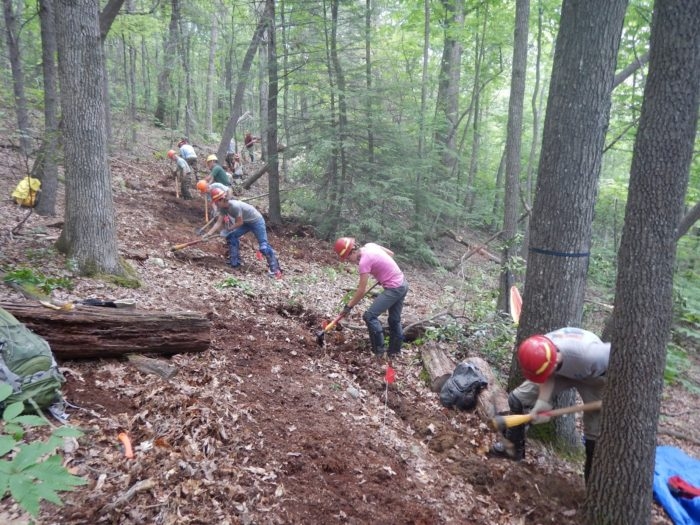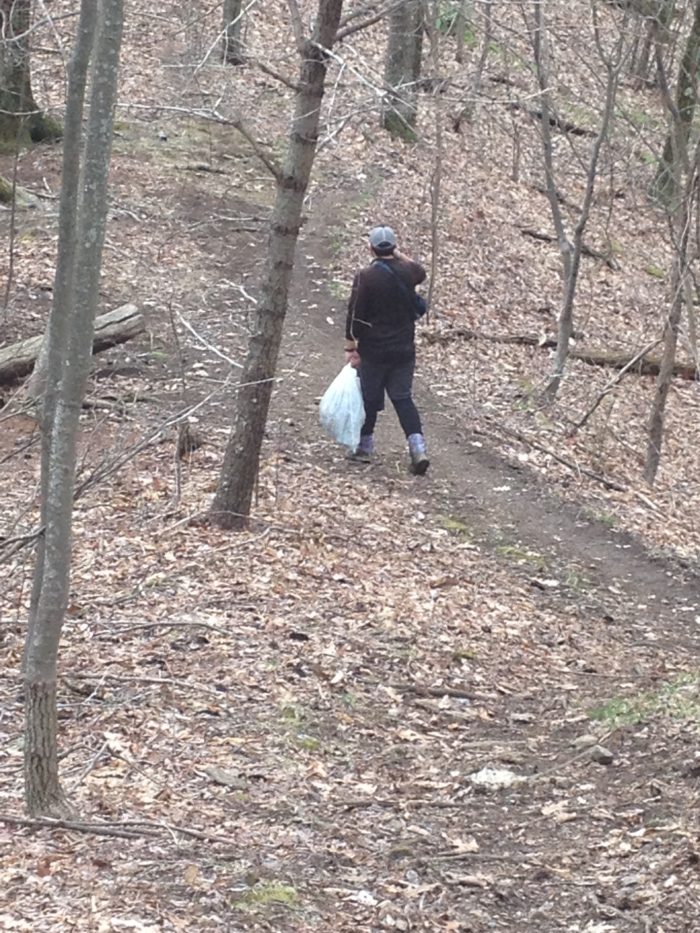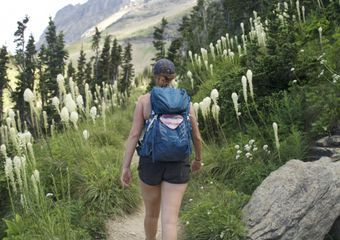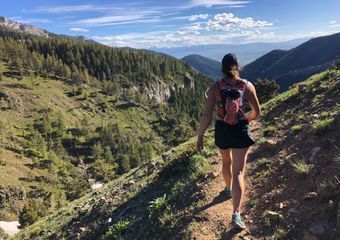Five Trail Resolutions for the New Year
We take to the trails for a simpler life, engaging the rhythms of nature, joining a community of like-minded people. Our days on trail follow the rising and setting of the sun. Clean water quenches our thirst. If we’re lucky, we see the animals that inhabit the land we’re walking through. But as our numbers increase, as more and more people take to the trails that we love, what can we do to preserve the experience that we crave?
Some answers may seem to be common sense; others can lead to endless and heated online debate.
1) Leave No Trace
This should be simple. Carry out what you carry in. Tread lightly, and leave no sign of where you’ve been.
Instead, trash litters established campsites along trails. Stealth sites with fire rings are common. Feces and toilet paper aren’t buried properly.
Jim Fetig, the Potomac Appalachian Trail Club (PATC) ridgerunner coordinator and a Leave No Trace Master Educator, said keeping the trail clean is a continual battle.
“The synonym for ridgerunner is janitor,” he told The Trek in a recent story. “They haul tons of trash off the trail each season. Some hikers are receptive to Leave No Trace coaching while others resist, sometimes out of embarrassment. ‘What difference does the one tiny thing I’m doing make?’ they argue over and over, year after year. If you see the same trail section all summer or year after year, you know that not just one person is doing it and the additive impact can be huge.”
In fairness to thru-hikers, if they don’t start out as LNT adherents, most catch on quickly.
The Leave No Trace Center for Outdoor Ethics estimates that nine of ten people in the outdoors don’t know what effect they’re having on wilderness and recreation areas.
What you can do: Stay on established trails. Don’t make shortcuts or switchbacks. Carry out your trash, and, if possible, someone else’s you found along the trail. Volunteer for a local outdoor cleanup.
2) Respect the Wild
Bears are increasingly associating hikers with easy food. Bear hangs can be sloppy. Some hikers don’t secure their food.
“A poor bear hang, in my mind, is almost worse than no hang at all,” Laurie Potteiger, information services manager for the Appalachian Trail Conservancy (ATC), told Trek writer Clay Bonnyman Evans recently. “Bears become habituated to look for them, and that’s what has caused our biggest problems.”
Bear canisters are required on parts of the Pacific Crest Trail and the Appalachian Trail. Several national parks and forests also require them.
The ATC recommends bear canisters, but doesn’t require them.
It’s not just bears that look for food at shelters or established campsites.
“Beyond bears, think about the other critters seemingly simple food crumbs attract,” Fetig told The Trek. “First come the mice, then all the other animals, such as snakes, that eat them. Ultimately, the entire food chain shows up. Even ramen crumbs under the picnic table have an impact.”
What you can do: Ensure that your food is stored properly so animals cannot get it. Don’t burn food scraps or packaging in a campfire. Use bear boxes if they are available at shelters or campsites. Give serious consideration to carrying a bear canister.
3) Practice Sustainability
The outdoor industry, especially clothing manufacturers, is at the forefront of environmental sustainability. Patagonia and Mountain Hardwear are making clothes from recycled products. North Face and REI, among others, sell used gear and clothes. Facebook groups provide a space for private sellers and buyers to connect. Also, consider environmentally friendly personal hygiene products when packing for a hike.
What you can do: Consider buying used gear. Think about recycled products. And check a company’s website to determine whether its manufacturing follows sustainable practices.
4) Volunteer Your Time with Trail Maintenance

Image courtesy Appalachian Trail Conservancy
Did you ever quietly bless the workers who cleared the blowdowns after a storm? Or praised the people who constructed stone steps up the side of a steep climb? The volunteer population is aging, and trail clubs are actively looking for strong, able-bodied volunteers to help maintain sections of trail and contribute to sustainable construction.
That work didn’t come easily. Here are some numbers from the Pacific Crest Trail Association on the work in 2014 by its staff, nonprofit partners, and volunteers:
1,712 miles of trail maintained.
46 miles of trail restored/reconstructed.
Two trailhead kiosks constructed.
3,384 square feet of cribbing constructed.
183 feet of turnpike/puncheon constructed.
PCTA volunteers, including non-trail maintenance activities, contributed an in-kind value of $1.86 million in 2014.
What you can do: Volunteer with a trail club. Contribute financially to an outdoor organization.
5) Do the Right Thing

Image courtesy Maggie Slepian
All the previous building blocks lead to this: Do the right thing. But what does that mean? Carry out your trash? Pick up trash left behind by other hikers? Share food or water with a fellow hiker who’s run short? Be an emotional support for someone on a down day?
Sometimes we succeed. Other times we fall short.
A troubled hiker arrested for threatening others on the Appalachian Trail in spring 2019 was released after pleading guilty to lesser charges. The sheriff in Unicoi County, Tennessee, said he tried unsuccessfully to get hikers to testify against the arrested man.
The man returned to the trail, where hikers exchanged messages alerting each other where he was. Tragically, that didn’t help. He killed a hiker and severely wounded another in Virginia.
Did hikers do all they could to keep the trail safe? Did authorities do the same for a man with a documented history of trouble. These are questions with no easy answers, but ones that should never be forgotten.
What you can do: Take reasonable actions that ensure the safety of the trail community. Notify authorities or the ATC of potential trouble on trail. Be alert, be aware, and be part of a sustaining community.
Feature image courtesy of Colleen Goldhorn.
This website contains affiliate links, which means The Trek may receive a percentage of any product or service you purchase using the links in the articles or advertisements. The buyer pays the same price as they would otherwise, and your purchase helps to support The Trek's ongoing goal to serve you quality backpacking advice and information. Thanks for your support!
To learn more, please visit the About This Site page.






Comments 6
Very interesting and good your article. After read the whole article I feel something good krogerfeedback thoughts which are expected for me. Thanks a lot
Another easy way to grok all of this is to always respect the hiker who will be coming behind you. Your action (or inaction) affects their experience.
Also, ATC is not the authority that decides whether canisters are required or not (‘tho they do play a significant advisory role)–it’s up to the land-manager of each forest and park the Trail traverses. I think the writing is on the wall for food hangs. Expect to see bear canister use required on a significant amount of the AT in the next few years–probably a good thing overall.
Cosmo
Very impressive and good your study. After reading the full article I think something good thoughts which are expected for me and my site. Thanks a lot
You know your projects stand out of the herd. is something special about them. It seems to me all of them are really brilliant!
https://krogerexperiencee.com/tellthebell-taco-bell-customer-satisfaction-survey/
Awesome blog. I enjoyed reading your articles. This is truly a read for me. I have bookmarked it and I am looking forward to reading new articles. Keep up the good work!
https://krogerexperiencee.com/tellthebell-taco-bell-customer-satisfaction-survey/
This is very useful, although it will be important to help simply click that web page link: